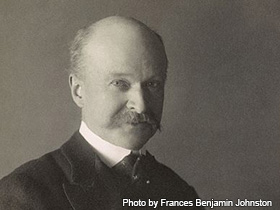American Academy in Rome; Columbia College; ??cole des Beaux Arts, atelier Daumet in France; Gold Medal of the American Institute of Architects; King's medal of the Royal Institution of British Architects; The Lawrence Scientific School, Harvard University; Royal Gold Medal in Architecture.
Charles F. McKim was born in Isabella Furnace, Pennsylvania, in 1847. He was schooled in New Jersey and Philadelphia and then studied at Harvard and an arts school in Paris. Upon his return to the United States he began working at an architectural firm in New York. After working there for seven years, he opened his own firm, which became the largest, most influential firm in the U.S. by 1879. McKim and his firm designed many well-known buildings over his 30 years working there. Charles McKim died suddenly in 1909, but his firm was still successful after his death.
Charles Follen McKim was born August 24, 1847, in Isabella Furnace, Pennsylvania. His father, James M. McKim, was a Presbyterian clergyman and was also a leading activist for the abolitionist cause. Mr. McKim was overseas when Sarah McKim, his wife, was visiting her sister, whose husband owned and operated Isabella Furnace. Charles McKim had a sister Lucy, who was five years older and an adopted sister named Annie. Later in his life, his religion and family, especially his father, had a positive impact on his ambitions and style.
At the age of ten, Charles McKim was sent to Theodore D. Weld School in New Jersey and then attended a Philadelphia public school for three years. When he was 16, Charles decided to go on a walking tour of Gettysburg with some of his friends. He then moved on in 1866 to study at the Lawrence Scientific School at Harvard University for a year. After discovering his interest in architecture he traveled to Paris to study at the École des Beaux-Arts, atelier Daumet, for three years. McKim spent the following two years traveling around Europe studying architecture before returning back to the United States in 1872. Upon his return he got a job working for Henry Hobson Richardson and his firm.
Over the next seven years he worked for the Gambrill and Richardson firm where he met future partners William Mead and Stanford White. In 1872, McKim opened his own office in New York and was joined by his friend William Mead. In 1878, William Bigelow joined the firm but retired one year later and was replaced by Stanford White. In 1879, Charles McKim established the McKim, Mead and White architectural firm. The focus of these three architects was to convey a national style by using geometrics, symbolism, and classicism. McKim himself loved residential and civil architecture and the use of red brick and white limestone. He focused on a Colonial and Early Republican Era and Italian Renaissance-like style. The majority of his work was college and university buildings, libraries, banks, churches, hotels, and private residences. Most of his projects were along the east coast in New York City, Massachusetts, and Connecticut, but he did have other projects, such as in Illinois and Oregon.
For the first ten years, the firm was working solely on private residences and summer cottages. As McKim and his firm began to gain some recognition, they were called on for larger more involved plans. McKim's first major project was the Newport Casino in 1881. From then on he was requested to help design many large and prominent projects, such as the Portland Hotel in Oregon and the Agricultural building at Chicago's World Fair. The firm of McKim, Mead and White became the largest and most influential architectural office in America between the years of 1879-1912. They employed more than 100 personnel and became the model for modern architecture, creating standards for generations to come.
Among some of their larger projects were the Boston Public Library, Morgan Library, the Rhode Island State Capitol, and the Pennsylvania Station. In New York, McKim designed the original Madison Square Garden, the original plan for Columbia College (now Columbia University), and many University clubs in which he became a member. He did a lot of work with other major universities and colleges, such as Amherst, Bowdoin, Brown, Cornell, Harvard, Hartford, New York University, Princeton, the University of Illinois, and the University of Virginia. He designed buildings, including laboratories and observatories, libraries, gates, and helped to establish a traveling scholarship in the architecture program at Columbia. His works conveyed an Italian architectural style. Paul Goldberger of the New York Times commemorates this style 78 years later in his 1987 article, "A Baker's Dozen of New York's Urban Masterpieces," by saying, "Charles McKim and so many of his contemporaries, were able to put modern buildings into historical garb and make the whole thing seem right at home." McKim had a way of expressing the national style of renaissance and making it fit wherever his design was located.
In 1895 the American Academy in Rome, Italy, that McKim had been working on for two years was finally finished and opened. Two years after, he was elected president of the Academy. Subsequently, in 1900 he was awarded the royal gold medal at the Paris Exhibition for his contributions to architecture. Three years later he received the King's Medal from the Royal Institute of British Architects for his work as well. After his death in 1909, the American Institute of Architects (AIA) awarded him its gold medal for his well-known design and his role as President of the AIA since 1902. Along with his election as president of the AIA, he was part of the Architectural League, the Society of Mural Painters, the National Academy of Design, the Municipal Art Society, the Metropolitan Museum of Art, and the American Fine Arts Society. One of his greatest honors was being by President Roosevelt to design renovations for the White House. Throughout his 30 plus years of work he received many awards and recognition from significant people all over the world.
Charles McKim died on September 14, 1909, in St. James, New York, subsequent to suffering a nervous breakdown and ill health after longtime partner Stanford White was murdered. In 1922 a memorial to honor McKim's work and his founding of the American Academy in Rome was planned by alumni members of the American Institution of Architects. In addition, J.D. Rockefeller Jr. gave a generous $200,000 gift to the American Academy in Rome. According to the New York Times article, "Art Societies Pay Tribute to M'Kim," at a memorial ceremony the ex-ambassador of the Court of St. James, Joseph H. Choate, referred to McKim as "the long recognized leader in his profession." He also stated that his qualities of simplicity and beauty came from his Quaker parents and the Quaker way of life. As for the firm, his longtime partner William R. Mead continued working there until his retirement in 1920.
- Boston Public Library. Boston, Massachusetts: 1887-1895
- Agriculture Building at the Chicago World's Columbian Exposition. Chicago: Illinois 1890-1893
- The Original Madison Square Garden. Madison Avenue, New York City, NY: 1891
- American Academy. Rome, Italy: 1895
- Rhode Island State Capital. Providence, Rhode Island: 1895-1903
- University Club, Madison Avenue. New York City, NY: 1900
- Improvements to the White House. Washington, DC: 1902
- The Original Columbia College Campus Plan. New York: 1904
- Morgan Library. New York: 1906
- Pennsylvania Station. Southampton, New York: 1904-1910
- "Art Societies Pay Tribute to M'Kim." New York Times (24 Nov. 1909): 8.
- Dolkart, Andrew S. "The Architecture and Development of New York City." Key Figures, Columbia University. 2006. Columbia University. 24 Nov. 2006. <http://nycarchitecture.columbia.edu/global/ 0241_key_figures.html>.
- "Encyclopedia of World Biography on Charles Follen McKim." Book Rags. 2005. Encyclopedia of World Biography. 22 Nov. 2006. <>http://www.bookrags.com/Charles_Follen_McKim>.
- Goldberger, Paul. "A Baker's Dozen of New York City's Urban Masterpieces." New York Times (31 July 1987): C1.
- Matthews, Kevin. "McKim, Mead and White." Artifice, Inc. 2006. 20 Sept. 2006. <http://www.greatbuildings.com/architects/ McKim_Mead_and_White.html>.
- "McKim, Charles Follen." HighBeam Encyclopedia. 2006. Columbia University. 24 Nov. 2006. <>http://www.encyclopedia.com/doc/1E1-mck1im-c1h.html>.
- "Memorial to Charles F. McKim Planned by American Architects; Founder of American Academy in Rome to Be Honored by Members of the Alumni—a $200,000 Gift by John D. Rockefeller Jr." New York Times (9 July 1922): 96.
- Moore, Charles. The Life and Times of Charles Follen McKim. Boston: Houghton Mifflin Company, 1929.
- Roth, Leland M. McKim, Mead and White, Architects. 1st ed. New York: Harper and Row, 1983.
- White, Samuel G. "Buffalo as an Architectural Museum: McKim, Mead and White in Buffalo." The Buffalo Free-Net. 1988. 20 Sept. 2006. <>http://freenet.buffalo.edu/bah/a/archs/mck/>.
- White, Samuel G. "Stanford White in Saint James, New York - Houses by Architectural Firm McKim, Mead and White Founded in 1879." Find Articles. July 1998. LookSmart, Ltd. 20 Sept. 2006. <http://findarticles.com/p/articles/mi_m1026/is_n1_v154/ ai_20979634>.
- Wilson, Richard G. Charles F. McKim and the Development For the American Renaissance: a Study in Architecture and Culture. Vol. 1-4. Ann Arbor: University Microfilms International, 1984.
For More Information: On these websites, one can find pictures of Charles McKim's American Academy in Rome and other projects by him and the firm.
- <http://www.nyc-architecture.com/ARCH/ARCH- McKimMeadandWhite.htm>
- <>http://www.aarome.org/buildings.htm>
Born in Isabella Furnace, architect Charles McKim sought to create an American national style of architecture.

